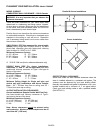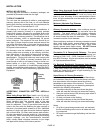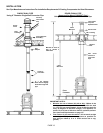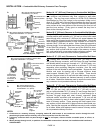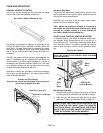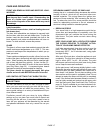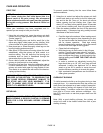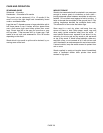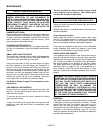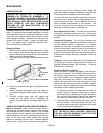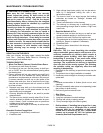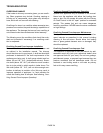
CARE AND OPERATION
PAGE 17
FRONT ASH REMOVAL DOOR AND SIDE FUEL LOAD-
ING DOOR
CAUTION: When opening the doors, do not extend
them beyond their normal travel. Overextending the
doors to a further open position can put excessive
stress on the hinge area of the doors which may result
in breakage.
Latch Assemblies
(For front ash removal door, side fuel loading door and
ash drawer door).
The door latch assemblies are designed to securely latch
the front door, side door and ash drawer door. To open the
latches, insert the door handle (provided) into hole in the
latch assembly and rotate counterclockwise until door re-
leases. To close and latch, reverse the process
GLASS
The glass is a 5mm super heat resistant ceramic that with-
stands continuous temperatures up to 1256° F. This tem-
perature is well beyond the temperatures in which you op-
erate your stove.
These models are designed to provide a flow of air over the
inside of the glass, where along with high heat helps keep it
clean. When operating the stove on low for extended peri-
ods of time, the glass may get dirty. A short, hot fire (15 -
20 minutes) will help clean off much of the normal buildup
(see Dirty Glass, page 23). A commercial glass cleaner
designed for stoves is recommended for cleaning.
The glass should be cleaned thoroughly with glass
cleaner and a soft cloth BEFORE the stove is burned.
USE CONTROL SETTINGS THAT WORK FOR YOU
CAUTION: NEVER LEAVE STOVE UNATTENDED ON
HIGH SETTINGS.
The fuel, the amount of heat you want, the type of instal-
lation you have and how long you wish the fire to burn
are all variables that will affect the control setting. The
same control settings in a variety of installations will pro-
duce different results.
Familiarize yourself with your stove by trying different
settings so you can learn how much heat to expect and
how long the fire will burn. It may take a week or two to
learn but your patience will be rewarded by the warmth
and pleasant satisfaction that only a wood fire can pro-
vide.
REPLENISH HUMIDITY LEVEL OF DWELLING
Heating the air in a closed building decreases the relative
humidity of the air, which will dry wood and other com-
bustible materials. This drying lowers the ignition tem-
perature of these materials, thus increasing the fire haz-
ard. To reduce the risk of fire, some provision should be
made for replenishing moisture to the air whenever a
structure is being heated for extended periods.
• BREAK-IN PERIOD
Your stove finish is a high temperature paint that re-
quires time and temperature to completely cure. We
recommend that you ventilate the house during the
initial burns. The paint emits non-toxic odors during
this process.
KEEP YOUR HOUSE WELL VENTILATED DURING
THE CURING PROCESS TO PREVENT ACTIVA-
TION OF YOUR HOME SMOKE DETECTOR.
It will take approximately three burn cycles to cure the
paint. The first two burns should be low heat, ap-
proximately 250°F., for 20 minutes each, using paper
and light kindling.
After each 20-minute burn, allow the appliance to cool
completely. The third burn should be at least medium
high or about 450°F. for 45 - 60 minutes. The paint
will become soft and emit non-toxic haze during these
burns. Keep the area well ventilated.
As the paint cures it will become slightly lighter in color.
Eventually the entire surface will become an even color.
Once the paint has been softened and cooled two or
three times, it will harden. Do not place anything on the
stove surface until the paint is completely cured. Do not
attempt to repaint the stove until the paint is completely
cured. If the surface later becomes stained or marred, it
may be lightly sanded and touched up with spray paint
from the same paint (See Small Area Paint Touch-up,
page 21). Paint is available at your local authorized Len-
nox Hearth Products dealer. Never attempt to paint a
hot stove.



